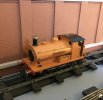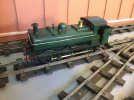Hello
I actually joined this forum last year, a first for me as I have never used social media or anything similar. So, in the process of discovering how these things work, I now see there is a facility to introduce oneself. Hence this ‘Hello’.
I have found some amazing modelling on this site. In terms of modelling approaches and techniques, I have already discovered more ‘unknown unknowns’ than I thought possible. I hope to learn from others and will apply what is relevant as best I can to building (and I hope completing) my own layout.
My real railway interests are very wide, from current operation to 19th century, but essentially UK railways of all kinds. I am old enough to remember seeing one BR steam engine in service on a family holiday in 1967 or ‘68. I did see industrials in South Wales (and elsewhere) in the late 1970s. Mostly though teenage memories are traditional railway, 16t minerals full of coal in NE England and later South Wales, albeit Diesel hauled with 37s, 40s etc.
The wide interest in real railways has resulted in me never being able to agree with myself on a single period for modelling. Over the years, I have acquired a diverse selection of rolling stock and locomotives, nearly all 0 gauge. Essentially, the only common factor was I liked the prototype enough to buy the model. About twenty years ago, a start was made on an 0 gauge layout. The baseboards were built, some track laid and a few small elements of scenery constructed. Progress since has been glacial and intermittent as the rest of life took priority. Last year, I retired and have resolved to progress the layout, at the very least much more quickly, but ideally to a point where it can be operated, and in a perfect world to finish it.
I have a particular liking for vintage models. Whilst not finescale, and nowhere near as visually accurate as today’s models, there is a sort of authenticity that comes from being not a model of a locomotive built in the 1930s, but genuinely a locomotive built in the 1930s. As a teenager, I read about Crewchester, the Sherwood Section of the LMS and Paddington to Seagood. Those were the layouts I wanted to emulate. Complete systems that allowed railway-like operation. There is no possibility of me having anything of the size or complexity of those lines. But I have a space 23’ x 10’ and I aim to build something that follows the same general approach. I am not sure my efforts will be of much interest to others as this is definitely not pioneering development of new techniques. I aim however to capture something of the character of the traditional railway. I would be happy to post on layout progress if there is interest, but really I am here to watch and learn.
Martin
I actually joined this forum last year, a first for me as I have never used social media or anything similar. So, in the process of discovering how these things work, I now see there is a facility to introduce oneself. Hence this ‘Hello’.
I have found some amazing modelling on this site. In terms of modelling approaches and techniques, I have already discovered more ‘unknown unknowns’ than I thought possible. I hope to learn from others and will apply what is relevant as best I can to building (and I hope completing) my own layout.
My real railway interests are very wide, from current operation to 19th century, but essentially UK railways of all kinds. I am old enough to remember seeing one BR steam engine in service on a family holiday in 1967 or ‘68. I did see industrials in South Wales (and elsewhere) in the late 1970s. Mostly though teenage memories are traditional railway, 16t minerals full of coal in NE England and later South Wales, albeit Diesel hauled with 37s, 40s etc.
The wide interest in real railways has resulted in me never being able to agree with myself on a single period for modelling. Over the years, I have acquired a diverse selection of rolling stock and locomotives, nearly all 0 gauge. Essentially, the only common factor was I liked the prototype enough to buy the model. About twenty years ago, a start was made on an 0 gauge layout. The baseboards were built, some track laid and a few small elements of scenery constructed. Progress since has been glacial and intermittent as the rest of life took priority. Last year, I retired and have resolved to progress the layout, at the very least much more quickly, but ideally to a point where it can be operated, and in a perfect world to finish it.
I have a particular liking for vintage models. Whilst not finescale, and nowhere near as visually accurate as today’s models, there is a sort of authenticity that comes from being not a model of a locomotive built in the 1930s, but genuinely a locomotive built in the 1930s. As a teenager, I read about Crewchester, the Sherwood Section of the LMS and Paddington to Seagood. Those were the layouts I wanted to emulate. Complete systems that allowed railway-like operation. There is no possibility of me having anything of the size or complexity of those lines. But I have a space 23’ x 10’ and I aim to build something that follows the same general approach. I am not sure my efforts will be of much interest to others as this is definitely not pioneering development of new techniques. I aim however to capture something of the character of the traditional railway. I would be happy to post on layout progress if there is interest, but really I am here to watch and learn.
Martin



